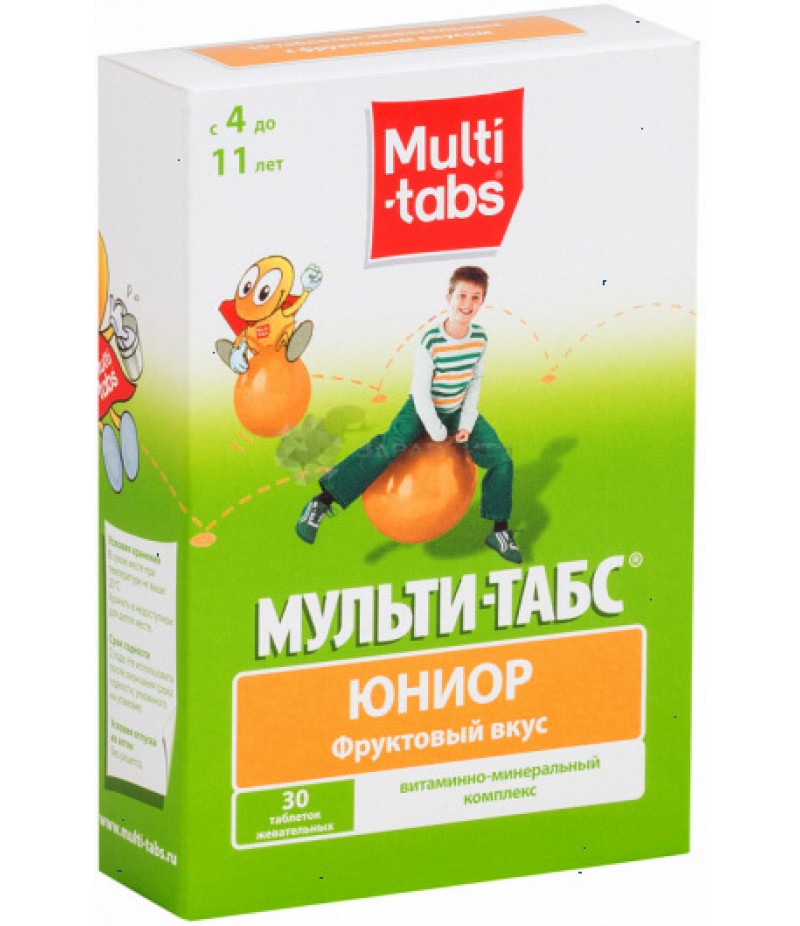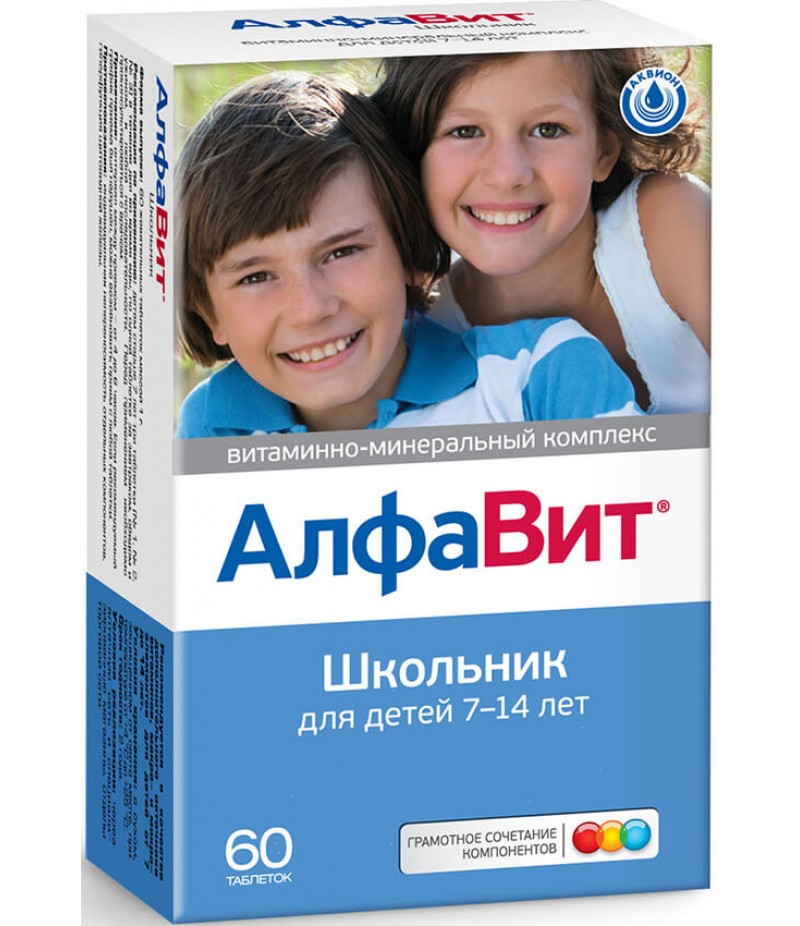Vitrum Junior tabs #30
- $29.98
- 3 or more $28.90
- Availability:In Stock
Instruction for Vitrum JuniorYou can buy Vitrum Junior hereCompositionThe composition of one chewable tablet includes: retinol acetate (vitamin A) - 5000 IU (which corresponds to the content of retinol - 1.72 mg)..
Tags: tabs
Instruction for Vitrum Junior
You can buy Vitrum Junior here
Composition
The composition of one chewable tablet includes:
retinol acetate (vitamin A) - 5000 IU (which corresponds to the content of retinol - 1.72 mg);
thiamine mononitrate (vitamin B1) - 1.5 mg;
colcalciferol (vitamin D3) - 400 IU (10 μg);
riboflavin (vitamin B2) - 1.7 mg;
calcium pantothenate (vitamin B5) - 10 mg;
phytomenadione (vitamin K1) - 10 μg;
Folic acid (vitamin B9) - 400 mcg;
pyridoxine hydrochloride (vitamin B6) - 2 mg;
ascorbic acid (vitamin C) - 300 mg;
cyanocobalamin (vitamin B12) - 6 mcg;
alfa-tocopherol acetate (vitamin E) - 30 IU (30 mg);
calcium (in the form of calcium hydrogenphosphate) - 160 mg;
nicotinamide (vitamin PP) - 20 mg;
phosphorus (in the form of calcium hydrogenphosphate) - 50 mg;
biotin (vitamin H) - 45 mcg;
copper (in the form of copper oxide) - 2 mg;
manganese (in the form of manganese sulfate) - 1 mg;
Magnesium (in the form of magnesium oxide) - 40 mg;
iron (in the form of iron fumarate) - 18 mg;
zinc (in the form of zinc oxide) - 15 mg;
iodine (in the form of potassium iodide) - 150 μg;
molybdenum (in the form of molybdate sodium) - 20 mcg;
Chromium (in the form of chromium chloride) - 20 mcg.
Excipients: sucrose, sorbitol, stearic acid, colloidal silicon dioxide, magnesium stearate, microcrystalline cellulose, orange flavor, citric acid, aspartame, pineapple flavor, yellow dye.
Form of issue
Vitrum Junior is available in the form of chewable tablets from pale brown to orange-brown in color, round in shape, flat, with a dividing strip from one side, with a fruity aroma, dark and light inclusions are possible.
60 or 30 such tablets in polyethylene bottles, one such bottle in a cardboard bundle.
pharmachologic effect
Replenishment of the shortage of trace elements and vitamins.
Pharmacodynamics and pharmacokinetics
Vitrum Junior is a balanced complex of minerals and vitamins for teenagers and children. Promotes harmonization of the functioning of the body, increases resistance to infectious organisms, activates recovery processes after diseases and injuries. Recommended for unbalanced nutrition, eating disorders.
Vitamin A is involved in ensuring the normal course of metabolic processes, as well as in regulating the development and growth of the body. Normalizes the function of the organ of vision, increases the body's resistance to the effects of hostile environmental factors.
Vitamin D3 increases the absorption of calcium in the intestines and phosphorus in the kidneys, ensures the correct construction of the skeleton and teeth in children.
Vitamin E is an antioxidant that inhibits the oxidation of fats, which is accelerated in most diseases. Prevents damage to cell components by free oxygen radicals. Participates in processes of cellular respiration, heme and protein synthesis, lipid and carbohydrate metabolism, cell differentiation and many others.
Vitamin C is involved in many types of oxidation-reduction reactions, regulation of carbohydrate metabolism, affects amino acid metabolism, biosynthesis of catecholamines, metabolism of thyroxine, steroid hormones and insulin. Regulates the permeability of capillaries. It increases the absorption of iron in the digestive tract and participates in the biosynthesis of hemoglobin. It has antitoxic properties. It is necessary for restoration of bone and connective tissue, synthesis of collagen.
Vitamin B1 normalizes the functioning of the digestive, nervous, endocrine system and cardiac activity.
Vitamin B2 promotes the process of body growth. Supports the processes of nonspecific immune response, normal eye function, affects the development of the nervous system and is involved in the synthesis of erythropoietin and hemoglobin. It activates the secretory function of the stomach, helps the absorption of carbohydrates in the intestine, is necessary to maintain a healthy intestinal microflora.
Vitamin B12 is characterized by high bioactivity and participates in all types of metabolism. Accelerates regeneration processes, regulates hemopoiesis, functions of the nervous system and liver, plays a role in blood clotting.
Vitamin B6 is an integral part of proteins involved in the metabolism of amino acids, fat metabolism. It is necessary for the proper functioning of the nervous system.
Folic acid is essential for the proper course of erythropoiesis. A participant in the biosynthesis of amino acids and DNA.
Nicotinamide stimulates the production of nicotinadine dinucleotide and nicotinenadinedinucleotide phosphate. These substances carry protons in oxidation-reduction reactions, this ensures the normal movement of metabolic biochemical operations.
Biotin (vitamin H) is a component of enzymes that regulate lipid and protein metabolism. It is necessary for the biosynthesis of higher fatty acids and some other sour acids.
Pantothenic acid activates the formation of corticosteroids. Participates in lipid and carbohydrate metabolism, production of acetylcholine. Provides the correct energy supply of the myocardium, accelerates the processes of tissue regeneration.
Vitamin K1 - an active component of proteins, providing a normal level of coagulation. Participates in metabolic processes in connective tissue and in bones. This vitamin provides the absorption of calcium and the interaction of calcium and vitamin D.
Calcium takes part in the formation of nerve impulses, in providing the motor function of smooth and skeletal muscles, myocardium, in the development of bone tissue.
Phosphorus is the structural part of all nucleic acids, nucleotides, phospholipids, phosphoproteins, cofenzymes, enzymes, an important element of tooth enamel and bones.
Magnesium provides many metabolic processes, neuromuscular excitability and conductivity, reduces the concentration of acetylcholine in the cells of the nervous system.
Copper - a participant in oxidation-reduction reactions, protects the body from the effects of free radicals.
Iron is an essential component of the structure of myoglobin, hemoglobin, cytochromes, and also a participant in a number of oxidation-reduction reactions. Without iron, hemopoiesis is not possible.
Zinc makes an important contribution to the biosynthesis of insulin, DNA, RNA, in the exchange of fats and proteins, contributes to the proper functioning of T-lymphocytes. It is an antioxidant.
Manganese (as a link in the structure and activator of enzymes) is a participant in a number of physiological processes.
Iodine is an essential component of the molecules of thyroid hormones involved in the adjustment of metabolic processes, in the activity of the brain, the cardiovascular and nervous system, the development of man, the formation of his mental abilities.
Molybdenum prevents the loss of fluoride. Has the ability to activate the destruction of purines and excretion of uric acid.
Chromium increases the effects of insulin.
Indications for use
Regulation of conditions associated with increased need for vitamins (a period of rapid growth, rehabilitation after illness, intense physical and mental stress).
Prevention and treatment of a deficiency of minerals and vitamins in adolescents and children.
Reduced resistance to infections.
Unbalanced and inadequate nutrition, a violation of the assimilation of minerals and vitamins.
Supportive treatment for chronic diseases, after surgery, active therapy with antibacterial and chemotherapeutic agents.
Contraindications
Hypercalcemia, hypermagnesia, hypercalciuria, chronic glomerulonephritis, renal failure, nephrolithiasis, sarcoidosis, hypervitaminosis E, A and D, active pulmonary tuberculosis, malabsorption syndrome, fructose intolerance, thrombophlebitis, metabolic disorder of copper or iron, severe kidney disease, gout, erythrocytosis, chronic cardiac insufficiency, thyrotoxicosis, gastric ulcer or duodenal ulcer, joint reception of retinoids.
Hypersensitivity to the drug or its components.
Children under 4 years.
Side effects
In rare cases, the following side effects occur.
From the skin: urticaria, rash, hyperemia, itching.
From the side of immunity: Quincke's edema, anaphylactic shock, fever and other allergic reactions.
On the part of the digestive system: nausea, dyspeptic disorders, vomiting, abdominal pain, constipation, diarrhea, increased acidity, heartburn.
From the central nervous system: headache, dizziness, excitability.
With long-term use in large doses, the appearance of mucosal irritation, hypercalciuria, hypercalcemia, arrhythmias, hyperuricemia, dry skin, paresthesia, hyperglycemia, a temporary increase in the activity of alkaline phosphatase and liver enzymes, seborrhea rash may occur.
Instructions for Vitrum Junior (Method and Dosage)
Instructions for use of the drug states that the reception should be done after eating by chewing the tablet.
Children aged 4 to 7 years take half the tablets per day, children age of 7 years and older - 1 tablet a day.
Overdose
In case of an overdose, nausea, abdominal pain, vomiting, skin rash, headache are possible.
Treatment: gastric lavage, symptomatic therapy if necessary.
Interaction
The content of calcium and iron in the preparation causes inhibition of absorption of tetracycline antibiotics and fluoroquinolones in the digestive tract.
Ascorbic acid activates the action of sulfonamides.
Preparations of iron and silver disrupt the absorption of vitamin E.
Antacids containing calcium, magnesium, aluminum, colestyramine reduce the bioavailability of iron.
Storage conditions
Store in tightly closed branded packaging at temperatures up to 30 degrees. Keep away from children.
Shelf life - 3 years.
special instructions
The drug should be used with caution in diseases of the liver, cholelithiasis, ulcer of the duodenum and stomach, diabetes mellitus, chronic pancreatitis.
Since the drug contains iodine, it is advisable for the physician to determine the appropriateness of taking it in persons with thyroid dysfunction.
It is not recommended to use Vitrum Junior together with other multivitamin complexes, because an overdose is possible.
Children
The drug is prohibited for children under 4 years.
Reviews about Vitrum Junior
The reviews are overwhelmingly positive, reports of the appearance of allergic reactions to the drug are not found.



